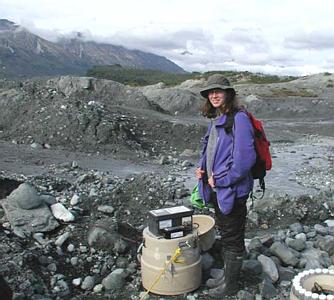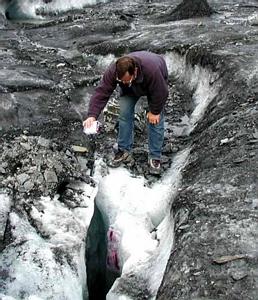20 July, 2000
July 20, 2000
Matanuska Glacier, Alaska
The off and on rain of the past nine or ten days dumped a little snow
into the higher elevations but once again today turned into a beautiful
day. Throughout the morning and afternoon the temperatures stayed very
comfortable and the sun stayed out most of the time. Fortunately I was
able to take a nice solar shower later in the afternoon. A cold breeze
developed later on and it’s a bit chilly tonight.
But we were fortunate to have these conditions to work in today as we
were in the field nearly all day. After getting all the necessary
equipment, supplies and lunches together we headed out to set up the
ISCO samplers. We had two of the REU students helping us today, Jessica
Terrien and Kevin Pemberton. Jessica and I paired up and went to Little
River Vent to program the ISCO, check things out and install a fresh
battery. We then headed to Trail Vent to do the same. While we were busy
with those two stations, Ben and Kevin set things up at two of the
Mammoth Vent stations.
We had everything set in place, ready to go by 9:45 and the dye was
dumped into the moulin at 10:30. The churning water was only about seven
feet from the surface and the dye produced a brilliant bright pink
froth. I then took the empty bottle up the rivulet a little bit to rinse
it out and the stream glowed brightly as the UV light from the sun
caused the dye to fluoresce. It was very pretty and quite unusual to
see.
We headed back to Trail Vent to see if there was any chance of seeing
some pinkness in the discharge but none was ever seen. We also noticed
that it had not taken the sample at 10:30 as it should have. An error
had been made on my part while setting the program. The clock on all the
ISCOs is set to Alaska Standard Time but the state operates on Daylight
Savings Time in the summer months (go figure with 24 hours of daylight).
And so when the start time was set, I mistakenly used DST. We quickly
rest the time and it was running smoothly again. Then I realized the
same error had been made at Little River. So off I went to reset that
one as well. It was not scheduled to collect its first sample till 11:00
so I managed to reset it before the first sample was schedule to be
taken.
We collected every 10 minutes for four hours from all stations except
Trail Vent. Due to its proximity to the moulin we sampled every five
minutes. At three o’clock all ISCO racks were collected and brought back
to camp where they were placed into a dark location. Light will cause
the dye to break down rapidly in low concentrations. They were protected
from the sunlight while inside the ISCO devices and we put them in dark
trash bags during transport. We are allowing the sediment to settle out
overnight and tomorrow we will check all 120 samples for presence of the
dye. It will be tedious but necessary work to do.
There was quite a bit of down time between lunch and removing the
collected samples. Jessica, Kevin and Ben went up the glacier exploring.
I was away at Little River and decided to take a shortcut across that
area of the glacier rather than walk back along the road. There was
quite a lot that captured my interest along the way. At one point I
climbed a high moraine and had a wonderful 360 degree view of the
glacier, surrounding mountains and the braided river valley below. It
was quite nice.
Marvin Giesting

REU student Jessica Terrien at the Trail Vent station.

I'm pouring the rhodamine dye into the moulin. The stream pouring into this moulin in front of me used to continue on behind me and emptied right next to Trail Vent. One day it suddenly formed this moulin and went dry the rest of the way.

The rhodamine dye fluoresced brilliantly as I rinsed the bottle in the stream. Hopefully it will appear in some of our samples tomorrow.
Contact the TEA in the field at
.
If you cannot connect through your browser, copy the
TEA's e-mail address in the "To:" line of
your favorite e-mail package.
|
